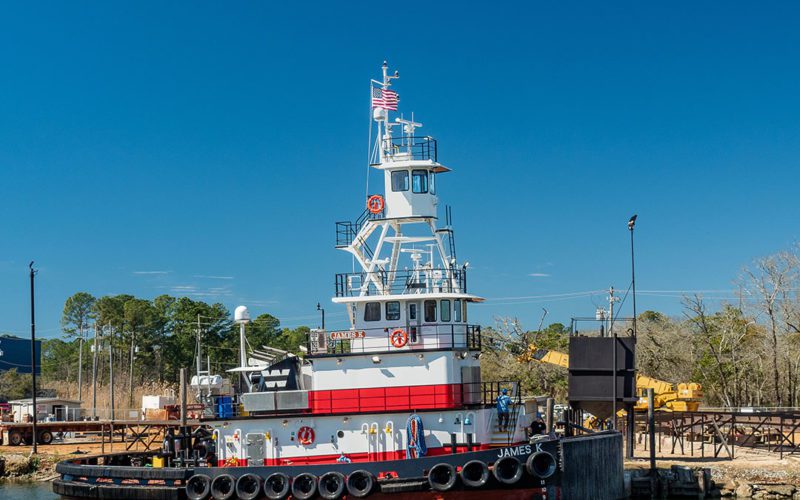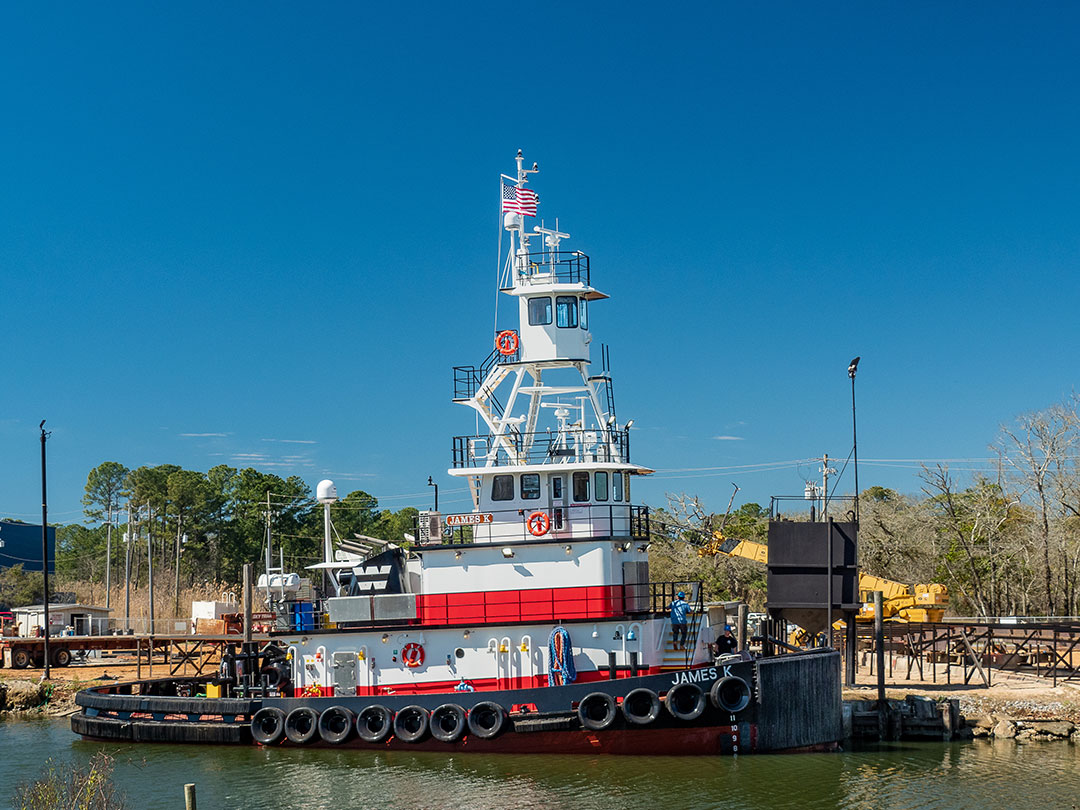
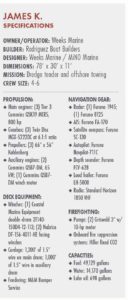 Weeks Marine builds versatility into triple-screw James K.
Weeks Marine builds versatility into triple-screw James K.
Weeks Marine of New Jersey developed a lugger tug design for three dredge tenders built at Rodriguez Boat Builders of Bayou La Batre, Ala. James K., delivered in late February, is the biggest and most capable of the trio.
Shaun O‘Brien, Weeks’ senior port engineer of towing, and project manager during the construction of the three tugs, considers the two 62.5-foot twin-screw tenders as multifaceted as a Swiss army knife. James K., the third tug in the series, is more like a rugged Leatherman.
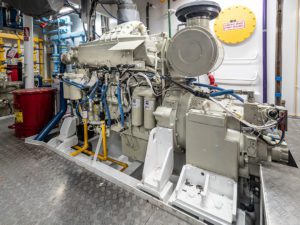
The 78-by-30-foot James K. is driven by three 800-hp Cummins engines. It is equipped with a much larger Coastal Marine Equipment aft towing winch than its sister tugs. It also has greater tankage capacities that allow for larger and longer tows.
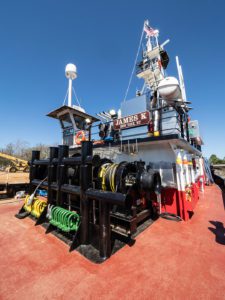
The three tugs, based on a Rodriguez design, are customized to Weeks’ specific needs for dredge tending. MiNO Marine of New Orleans was responsible for ensuring the tugs complied with the U.S. Coast Guard’s Subchapter M requirements.
Shipyard president Joey Rodriguez is no stranger to building nimble, shallow-draft, triple-screw lugger-style tugs. Those attributes are beneficial in the tight, shallow conditions common to dredge sites.
The two smaller tugs in the series, Jack K. and William O., feature the Rodriguez fish-tail rudder and inboard offset rudders designed to improve maneuverability. The rudders on James K. are in line. The inboard offset used on the smaller tugs was not necessary because of the increased rudder surface that better captures the thrust of the water flow.
“The handling is outstanding,” Dave Tuck, a Weeks engineer and project manager, said of the three boats.
Rodriguez noted that extending the leading edge of the rudders also contributes to what he calls a maximum performing rudder design. “After 44 years building boats, you learn a little bit about designing rudders,” he said. On deck for the future, Rodriguez has designed a quad- screw, quad-rudder, shallow-draft tug.
Weeks installed shaft brakes on James K., which contributes to the tug’s overall maneuverability. The shaft brakes, designed and supplied by Propulsion Systems Inc., are a caliper-style shaft brake actuated by a gearbox sensor.
“Maneuvering when doing close work is vastly improved,” O’Brien said. “This is accomplished with the quick-acting brake calipers that reduce shift delay from six to eight seconds to two to three seconds. This allows the operator a much more fluid and real-time adjustment to the vessel relative to the work.”
The three tugs have a host of robust characteristics to combat the elements and the rugged dredge site. The hull and side shell are made from half-inch steel plate, and the deck plates are 3/8-inch-thick steel. All deck connections, handrails and stern cap rail are made from stainless steel to prevent rust and future maintenance needs. The interior stainless-steel water piling is welded and flanged to prevent leaks.
“We have designed a backup battery system powered by lithium-ion batteries, which maintains the electronics, interior communication and lighting,” O‘Brien said. The interior lighting, half of which is on a backup system, is slimline LEDs, manufactured by Macris Industries.
James K. is powered by three Cummins QSK19-M mains coupled to Twin Disc MGX 5222 DC gears with a 6.10:1 reduction ratio. The 66-by-56-inch stainless-steel, four-bladed Kahlenberg wheels are pitched for torque rather than speed. A pair of Cummins QSB7-DM engines turning 60-kW generators supply electrical power.
The inventory advantages and efficiencies gained by using the same engine brand and model throughout a tug are being adopted as a fleet-wide strategy by Weeks Marine. “It‘s really nice having an all-Cummins package for lower maintenance and operating costs,” Tuck said.
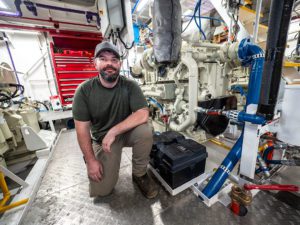
Accommodating the third engine on James K. meant adding to the beam. That, in turn, allowed for a shallower draft, which is an important asset in a dredging support tug. Another benefit is the larger engine room. Trevor Prendergast, deck hand-engineer on James K., said the spacious engine room allows for easier maintenance.
Another major departure from the two sister tugs is the large Coastal Marine hydraulic towing winch on James K. It is a side-by-side double-drum winch with an independent capstan. The main drum is wound with 2,000 feet of 1.5-inch wire and the secondary drum has 1,000 feet of 1.5-inch wire. A dedicated Cummins QSB7-DM engine drives the winch.
The winch can be utilized for tandem towing, pulling anchors and working alongside the dredge. Two Nabrico deck winches with 120 feet of 7/8-inch Spectra line on the foredeck are used for facing up to barges.
M&M Bumper Service of Bourg, La., provided the hull protection system that reduces wear and tear from handling anchors and pipe connections. The tire arrangement is directly connected to the hull, eliminating the need for noisy chain mounts that cause hull and tire wear.
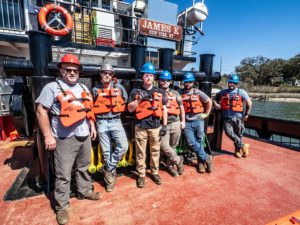
The accommodations for eight crewmembers were designed with comfort and endurance in mind. The floors are a 3/4-inch-thick Dex-O-Tex system with a rubberized overlay. “This flooring is robust, reduces engine room noise, and provides a comfortable walking surface,” O‘Brien said.
The practical reward for attending to crew comfort is less fatigue, which can boost morale and cause fewer mishaps. To that end, all bunks are fitted with a pillowtop twin XL mattress and television sets. Channels can be selected separately from all four cabins and the galley. Satellite internet and television are connected via KVH V7 and TV 5 domes.
The interior cabinetry is custom-built with hardwood panels and Perko hardware, and the countertops are granite. The galley is well laid out for efficiency in a compact area and has commercial-grade appliances with stainless exteriors.
Weeks Marine’s dredging division is one of the largest marine contractors in the U.S. and Canada. It operates a diversified fleet of dredging and support equipment. A few recent newbuilds include the suction dredge C.R. McCaskill, built at Weeks’ yard in Houma, La., and the trailing suction hopper dredge Magdalen, built at Eastern Shipbuilding of Panama City, Fla. A sister vessel to Magdalen, the future R.B.Weeks, is currently under construction at Eastern.
Jack K. is supporting dredging operations at the mouth of the Mississippi River, and the second tug, William O., is supporting dredging operations in Tampa. James K.’s first operation contract is on the East Coast. All three tugs are named for the children of company president Richard Weeks.
Weeks Marine is satisfied with the design and quality of work at the Rodriguez yard. Evidence of that approval comes from the company’s recent order for a new 72-foot pushboat from the Rodriguez shipyard.

